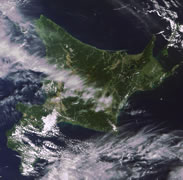Topics List
Aug. 7, 2017 Updated
KODAMA Ends Operations
|
At 2:45 p.m. (Japan Standard Time), August 5, 2017, JAXA sent a set of commands to shut down the operations of KODAMA, JAXA’s data relay test satellite.
|
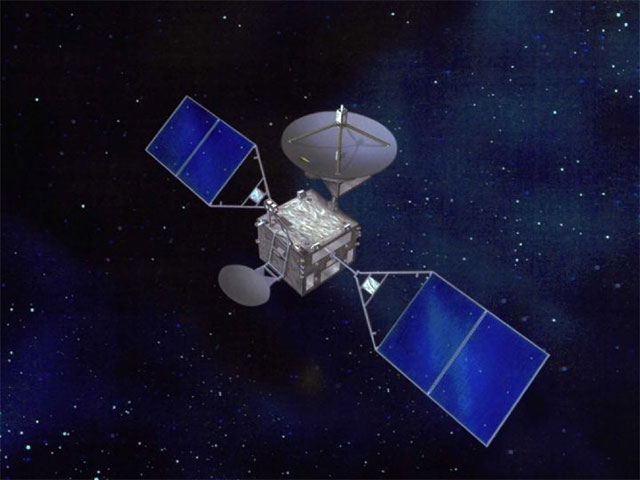
|
|---|
Sep. 10, 2012 Updated
KODAMA on-orbit operations mark 10 years
|
The KODAMA, which was launched on Sept. 10, 2002, has marked its 10-year anniversary. The KODAMA succeeded in a data relay experiment with the world's fastest speed of 278 Mbps using the Advanced Land Observing Satellite "DAICHI," and has been contributing to global land observations and disaster monitoring with the DAICHI by utilizing KODAMA’s broad view area and real-time and large-volume data relay capacity. Some 95% of DAICHI's 6.54 million scenes (or almost one PB of observation data) were received on earth through KODAMA's relays. |
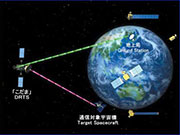
|
|---|
Oct. 7, 2009 Updated
KODAMA completes regular operation phase
|
The KODAMA, launched in September 2002, completed its six-and-half-year regular operation phase, and entered the post operation phase. |
 |
|---|
Dec. 1, 2006 Updated
Data relay experiments with ESA satellite
|
The Data Relay Test Satellite "Kodama" successfully carried out data relay experiments with the earth observation satellite "Envisat" of the European Space Agency (ESA). The experiments were performed in April and September, 2006, by coordinating the regular operation schedules of the two satellites.
|
Jan. 9, 2003 Updated
Kodama moved to the normal operation phase.
|
Kodama is expected to accumulate inter-satellite communication technology data by relaying communications between ground stations and satellites in low to middle altitude orbits (about 300 to 1,000 km), including Midori-II and Kibo, which will be launched in the future, during the 7-year operation phase of Kodama. |
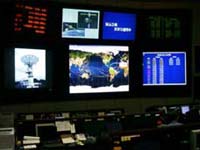 |
|---|
Sep. 17, 2002 Updated
"Kodama" completed its preparatory phase for initial functional verification
|
On Sep. 13 (Fri), the Data Relay Test Satellite "Kodama" launched at 5:20 p.m. on Sep. 10 (Japan Standard Time) was maneuvered to go into the drift orbit* whose altitude is approximately the same as the geostationary orbit by firing the apogee engine (the third apogee firing). The altitude of the satellite after the third firing, however, was lower than expected, thus it was further controlled on the 14th (Sat), and, consequently, "Kodama" was successfully placed into the scheduled orbit. |
 |
|---|
Sep. 10, 2002 Updated
Nickname is "Kodama" (meaning an echo)
|
The National Space Development Agency of Japan (NASDA) launched the H-IIA Launch Vehicle No.3 (H-IIA F3) at 5:20 p.m. on September 10, 2002 (Japan Standard Time) from the Tanegashima Space Center. The H-IIA F3 was loaded with two payloads, the Data Relay Test Satellite (DRTS) and Unmanned Space Experiment Recovery System (USERS) Spacecraft. The launch vehicle was lifted off with its initial flight azimuth of 90 degrees. |
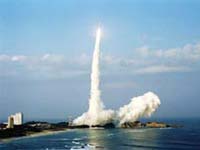 |
|---|
Sep. 4, 2002 Updated
Data relay station in the space
|
DRTS of NASDA will become a data relay station in the space. It will relay real-time data transmission between the ground and satellites that cannot directly send data to the ground. This relay technology will allow to extend the time of real-time data transmission dramatically. |
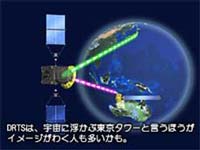 |
|---|
Sep. 2, 2002 Updated
Loaded on top of the launch vehicle
|
The fairing that encapsulates payload of H-IIA Launch Vehicle No.3 was transported from the Spacecraft and Fairing Assembly Building (SFA) to the Vehicle Assembly Building to be loaded on top of the launch vehicle. |
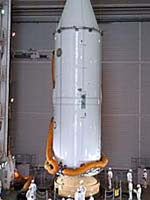 |
|---|
Aug. 22, 2002 Updated
DRTS and PAF mating
|
On Aug. 20 (Tue) and 21 (Wed), the Data Relay Test Satellite (DRTS) was mated with the Payload Attach Fitting (PAF) in the Spacecraft and Fairing Assembly Building (SFA) at the Tanegashima Space Center. The PAF is a mount to be loaded onto the launch vehicle, thus the mating operations were part of the fairing encapsulation and loading operation of the payload on top of the launch vehicle. |
 |
|---|
Jul. 27, 2002 Updated
DRTS Press release
|
DRTS, which is the first data relay satellite in Japan, is currently under launch preparation operations in the Spacecraft and Fairing Assembly Building (SFA) at the Tanegashima Space Center (TNSC). |
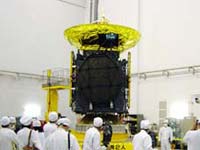 |
|---|
Jun. 14, 2002 Updated
|
The DRTS is shipped to TNSC and preparation for launch starts.The DRTS (Data Relay Test Satellite) was carried into the Spacecraft Test and Assembly Building No.2 in Tanegashima Space Center on May 2, 2002. From now on, the launch site work proceeds to final checkout and launch configuration setup for the launch in this summer. |
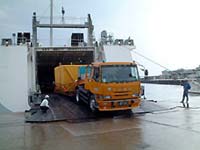 |
|---|
Feb. 13, 2002 Updated
|
The Proto Flight Test (PFT) for the Data Relay Test Satellite (DRTS) was completed as scheduled at the Tsukuba Space Center and the remaining tests are being conducted prior to delivery to the launch pad. |
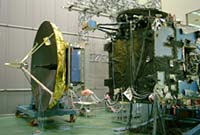 |
|---|
Apr. 24, 2001 Updated
DRTS System Proto-flight Test
|
System Proto-Flight Test (PFT) for DRTS is continuously progressing. The Shock Test has finished so far, and quasi-propellant is currently discharged and dried. After finishing the coming alignment measurement, final electrical performance test, UPS (Unified Propulsion Subsystem) functional test and mass properties test will start. |
 |
|---|
Mar. 27, 2001 Updated
System Proto-flight Test for DRTS Goes Well
|
In the series of the system proto-flight tests for DRTS, the system vibration test conducted from January to February 2001 has completed, and the shock test, which is to evaluate the endurance against the shock by pyrotechnics to separate the satellite from the rocket or to deploy the solar array paddles and antennas, is currently in operation. |
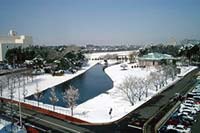 |
|---|
Nov. 17, 2000 Updated
|
We are now conducting Alignment measurement work from this month. The purpose of Alignment measurement is to confirm whether attitude system sensor that must meets precise requirements in its installment position and angle, and propulsive system thruster are installed correctly as required. After this work had finished, we will move on to mechanical environment tests such as acoustic test, vibration test, and shock test. |
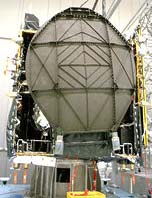 |
|---|
Aug. 25, 2000 Updated
Test Schedule for This Month
|
System Thermal Vaccum Test |
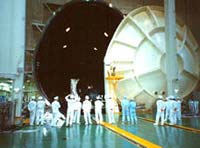 |
|---|
Jul. 21, 2000 Updated
System Thermal Vacuum Test Began
|
System Thermal Vacuum Test has began from this month. We now are going to conduct several tests in vacuum environment that simulates launch/on-orbit environment for approximately one month and prepare for a launch. |
 |
|---|
Apr. 21, 2000 Updated
|
We have investigated Tanegashima Launch Site. In this month, DRTS project team conducted the research on facilities at Tanegashima Space Center, which the rocket to be launched and condition of these facilities. The research was conducted with an investigation committee of the satellite maker who is responsible for launch site operation, both going to Tanegashima Space Center to confirm facilities. |
 |
|---|
Jan. 31, 2000 Updated
Main Tests Expected in January
|
Initial Electrical Performance Test |
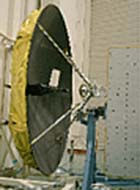 |
|---|
Dec. 17, 1999 Updated
DRTS - Main tests scheduled for December -
|
Initial electrical performance test |
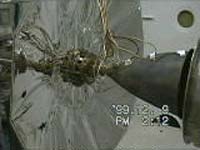 |
|---|
Nov. 19, 1999 Updated
Our Main Tests Scheduled This Month
|
Initial Electrical Performance Test |
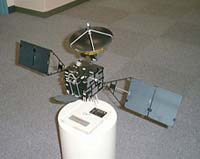 |
|---|
Oct. 15, 1999 Updated
Our Main Tests Scheduled This Month
|
Telemetry Tracking and Command Subsystem Test |
 |
|---|
Sep. 24, 1999 Updated
Proto-flight test is underway!
|
Our main tests scheduled this month are as follows. |
 |
|---|
Jul. 26, 1999 Updated
The Proto-flight Test Has Finally Begun
|
CDR (Critical Design Review) for the Data Relay Test Satellite (DRTS) is now finished and the system test is about to begin at the Tsukuba Space Center. |
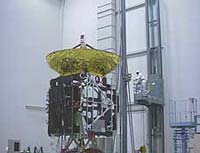 |
|---|

